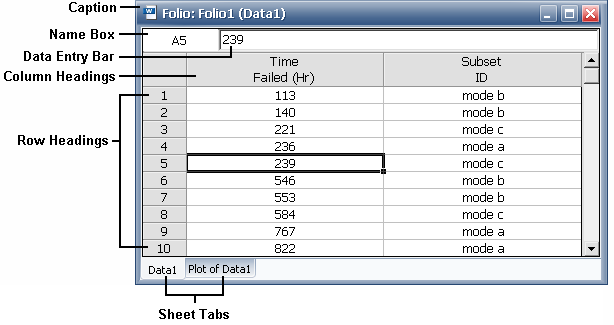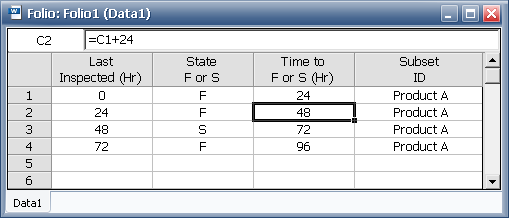

The data sheets in Weibull++/ALTA and RGA folios share some common components and features. The following picture shows the basic components of a data sheet using one particular format as an example.

Caption shows the name of the folio and the name of the sheet that is currently displayed.
Name Box shows the location of the currently selected cell by listing the column letter and row number that intersect at the cell's location.
Data Entry Bar shows the contents of the selected cell, which may be text, a numerical value or a formula. For text or numerical values, you can enter/edit the information directly inside the cell or inside the data entry bar. For a formula, you must use the data entry bar for editing; the cell will display only the calculated value.
Row Headings identify the row numbers. Each data sheet contains 65,536 rows. The application's speed of execution is inversely proportional to the number of data rows in the current data set.
Column Headings indicate the titles of the columns. To rename a heading, double-click the heading. When applicable, you can save the column titles and use them as the default headings for all new data sheets of the current type. (See Default Column Headings.)
Sheet Tabs represent the different sheets within the folio. To rename a sheet, double-click the tab. The number of folios that can be opened at once depends on the amount of memory of your system (up to a maximum of 256 for some folio types).
In standard folios, creating a new data sheet automatically populates that data sheet with default column headings that are generally appropriate for the analysis. If there are certain types of data that you frequently use (e.g., miles-to-failure, cycles-to-failure, etc.), you can customize the column headings to always use your preferred column titles.
To modify the defaults, first rename the column headings to the desired titles (by double-clicking the heading), and then save the new titles as the defaults by choosing [Life Data/ALTA/Growth Data] > Format and View > Set Headers as Default.
![]()
To apply the default headings to an existing data sheet, choose [Life Data/ALTA/Growth Data] > Format and View > Apply Default Headers.
![]()
To restore the default column headings back to the shipped settings, click Reset Application Settings or Reset All Settings on the Reset Settings page of the Application Setup (File >Application Setup).
Column widths are set to span evenly by default. If you want to resize and have the changes saved with the folio, right-click any column and choose Format Selection > Column Width Style > Keep as Set by User.
To resize a column, drag the edge of the heading to the desired position, or right-click it and choose Format Selection > Column Width.
To span the columns across the spreadsheet while keeping the ratio of the resized widths, right-click any column and choose Format Selection > Column Width Style > Span Proportionally.
Data sheets in Weibull++, ALTA and RGA allow you to enter formulas in columns that do not require entries to be dates, times or text (e.g., you cannot use formulas in the State F or S column in a Weibull++ standard folio, or in the Classification column in an RGA standard folio). For example, in a Weibull++ standard folio, if you have a data set where the units were inspected every 24 hours, you can speed up data entry by creating a formula to add 24 hours to the previous inspection time, as shown next.

There are two types of cell references (locations) when inputting a formula: absolute and relative. By default, the cell reference is relative, meaning that as a formula is copied and pasted to other cells, the cell references in the formula will be adjusted to reflect the new relative location. In the previous figure, the formula in cell C2 is copied and pasted into cell C4. This changes the cell reference in the formula from "=C1+24" to "=C3+24"; therefore, the time value in C4 is 72+24 = 96.
In contrast, an absolute reference does not change when the formula is copied to other cells. Absolute references are designated by placing a dollar sign ($) in front of the row and/or column to be made absolute. If the formula in the example were rewritten to "=$C$1+24", then copying the formula to cell C4 would retain the cell reference to C1 and the time value in C4 would be 24+24 = 48.
© 1992-2016. ReliaSoft Corporation. ALL RIGHTS RESERVED.
 |
E-mail Link |